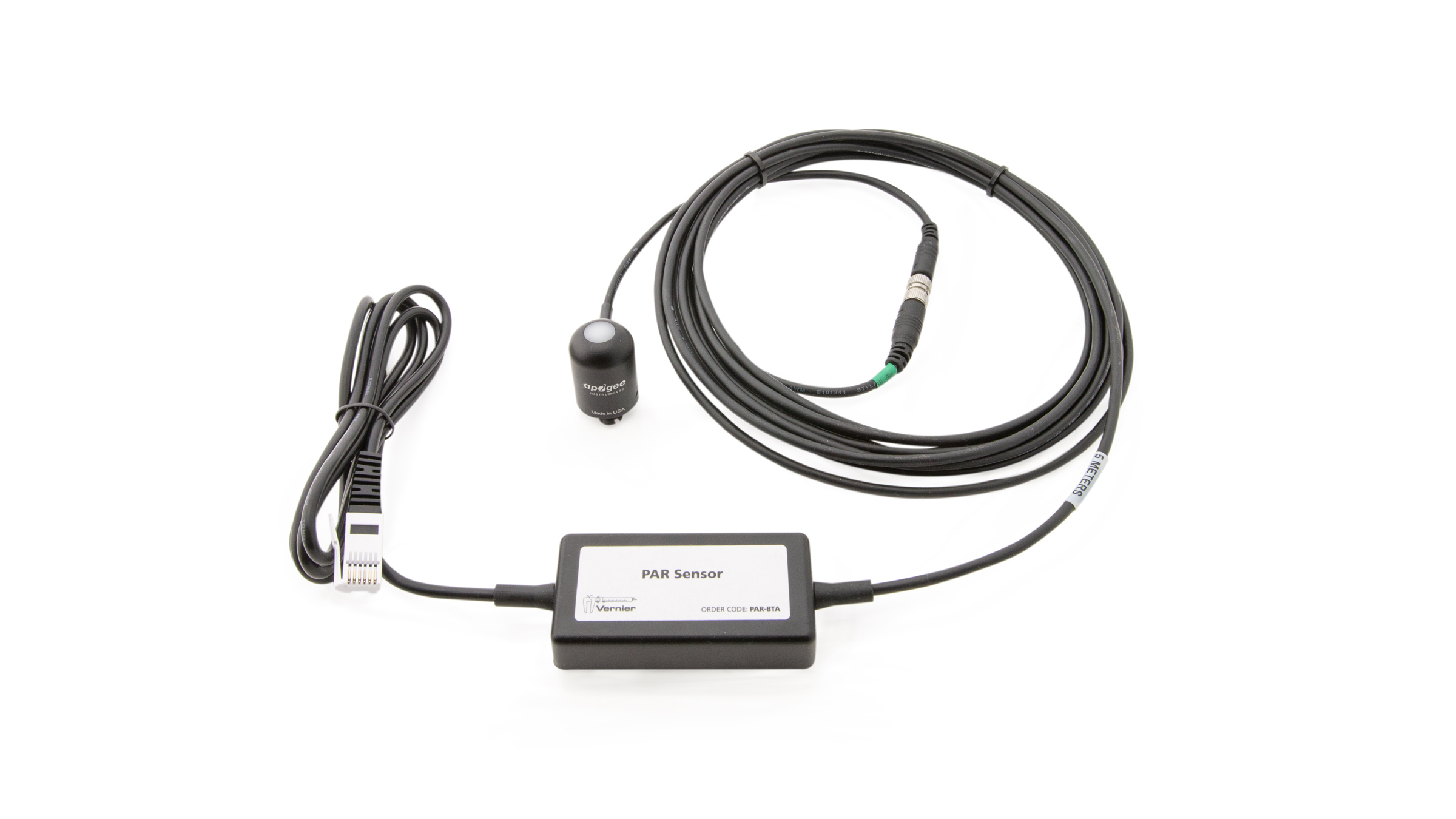PAR Sensor (PAR-BTA )

Which Apogee sensor head does my PAR Sensor have?
In May of 2023 the SQ-100X sensor head was introduced for the PAR sensor (previous model was SQ-110). The head of the new sensor is attached to the main cable using a P68-rated stainless-steel marine grade (M8) connector. This connector is located 25 cm from the sensor head. The sensor model number can be found on a white label wrapped around the cable that is located a few centimeters from the sensor head (SQ-100X-SS or SQ-110). The new sensor has a default calibration for solar radiation (outside light) and electric light sources.
Troubleshooting
- Primary Test: Make sure that the sensor detects sunlight. Values for a bright sunny summer day should approach 2000 µmol m‾²s‾¹ of photosynthetic photon flux.
- Secondary Test: If indoors, you can use an electric lamp that should produce a PAR reading greater than 10 µmol m‾²s‾¹. Place the sensor head approximately 10 cm away from a lit lamp source where values should be greater than the residual background value. When the PAR Sensor is used with some artificial lighting, the lamp flicker may cause a fluctuating signal.
To accurately measure light from an artificial source that uses LEDs, a correction factor must be used. See Can I use Vernier PAR sensors with electric lights? When do I need to use a Correction Factor?
Additional Troubleshooting
- How do Vernier PAR sensors work?
- How is Photosynthetically Active Radiation (PAR) Measured?
- Do I need to calibrate Vernier PAR sensors?
- How are Vernier PAR sensors calibrated?
- Can I calibrate my PAR Sensor using the clear sky calculator
- How do I clean a PAR Sensor?
- How do I apply a Correction Factor to Vernier PAR sensors?
- Can I use a Vernier light sensors to measure PAR?
- Are Vernier PAR sensors waterproof?
Specifications
- Sensing Element
⚬ Current: SQ-100x series quantum sensor (calibrated for sunlight and electric light sources)
⚬ Pre-May 2023: SQ-110 sensor (calibrated for sunlight) - PAR Range: 0 to 2500 μmol m-2 s-1 (PPFD) in full sun
- Absolute Accuracy: ±5%
- Repeatability: ±1%
- Long-Term Drift: Less than 2% per year
- Cosine Response:
⚬ 45° zenith angle: ±2%
⚬ 75° zenith angle: ±5% - Wavelength range: 370 nm to 650 nm
- Typical Resolution: 1 μmol m-2 s-1 (PPFD)
- Sensor dimensions
⚬ Diameter: 2.4 cm
⚬ Height: 3.3 cm
⚬ Cable length: 5 m - Materials: Anodized aluminum with case acrylic lens
- Operating Environment
⚬ Sensor Head and Cable
▸ –10 to 60 °C
▸0 to 100% relative humidity
▸Sensor head and cable can be submerged in water to the level of the sensor box.
⚬ Sensor Box
▸0 to 40 °C
▸Sensor box is not waterproof or weatherproof. - Default calibration coefficients: slope = 500 µmol m‾²s‾¹/ Volt; intercept = 0
Calibration
Calibrate? No. The sensor is set to the stored calibration before shipping. If you are suspicious about the calibration, there are two ways to check.
- Compare the PAR value with another Quantum sensor.
- Use the Clear Sky Calibration method. You will need a sunny day with no clouds or pollution effects.
- Access the Clear Sky website where you can enter data into the web application to have the photosynthetic photon flux (PPF) calculated.
- Input values for the calculation including latitude, longitude, altitude, time of day, day of year, air temperature, and relative humidity.
- You can compare the calculated value with the reading on the PAR Sensor.
- This procedure should be done at several different times. If the readings are consistently off, contact Vernier.
Note: Debris build-up on the lens of the PAR Sensor is a common cause of inaccurate readings.
Additional Products
Here are some additional products appropriate for experiments involving photosynthesis of plants, algae, and other photoautotrophs under terrestrial and aquatic conditions.
LABQUEST (WIRED) SENSORS
- Vernier Optical DO Probe (
ODO-BTA ) - CO2 Gas Sensor (
CO2-BTA ) - O2 Gas Sensor (
O2-BTA ) - Extra-Long Temperature Probe (
TPL-BTA ) - pH Sensor (
PH-BTA ) - Tris-Compatible Flat pH Sensor (
FPH-BTA ) - Conductivity Probe (
CON-BTA ) - Salinity Sensor (
SAL-BTA ) - Water Quality Bottles (8 bottles) (
WQ-BOT )
GO DIRECT SENSORS
- Go Direct® PAR (Photosynthetically Active Radiation) (
GDX-PAR ) - Go Direct® Optical Dissolved Oxygen Probe (
GDX-ODO ) - Go Direct® CO2 Gas Sensor (
GDX-CO2 ) - Go Direct® O2 Gas Sensor (
GDX-O2 ) - Go Direct® pH Sensor (
GDX-PH ) - Go Direct® Tris-Compatible Flat pH (
GDX-FPH ) - Go Direct® Conductivity Probe (
GDX-CON ) - Go Direct® Salinity Sensor (
GDX-SAL ) - Water Quality Bottles (8 bottles) (
WQ-BOT )
